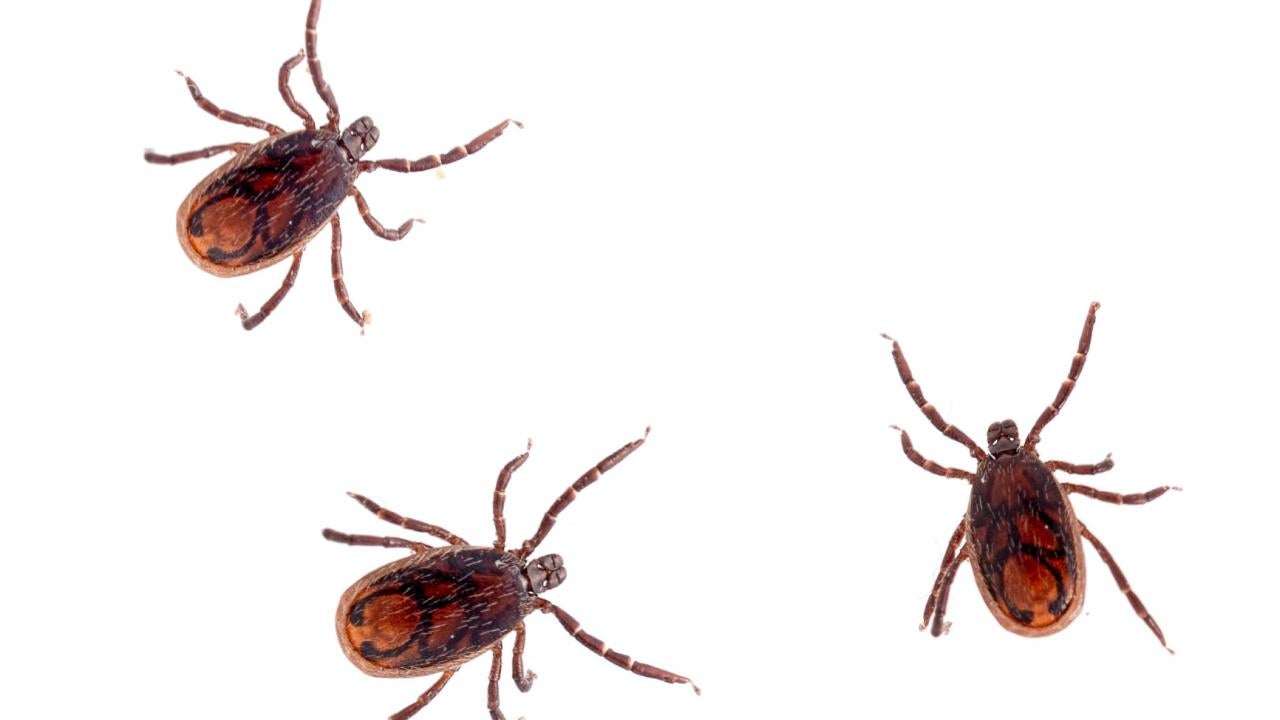Dog ticks that carry the bacteria causing the deadly Rocky Mountain Spotted Fever (RMSF) are twice as likely to choose humans over canines when temperatures rise. That’s according to UC Davis findings presented today at the annual meeting of the American Society of Tropical Medicine and Hygiene (ASTMH). The findings are an example of how climate change could expand and intensify human disease risks.
“Our work indicates that when the weather gets hot, we should be much more vigilant for infections of Rocky Mountain Spotted Fever in humans,” said Ph.D. student Laura Backus, who led the study at the UC Davis School of Veterinary Medicine in the lab of Professor Janet Foley. “We found that when temperatures rose from about 74 to 100 degrees Fahrenheit, brown dog ticks that carry the disease were 2.5 times more likely to prefer humans over dogs.”
Checking boxes
For the experiment, the scientists constructed two large wooden boxes measuring about 3 feet tall and 2 feet wide, which were connected by a clear plastic tube. They conducted a series of tests that involved putting a human in one box, a dog in the other and ticks in the clear plastic tube between them. Over 20-minute intervals, the researchers then observed whether the ticks preferred dogs or humans — first at temperatures of around 74 degrees Fahrenheit and then at 100 degrees Fahrenheit.

To study tick behavior toward humans and dogs amid rising temperatures, UC Davis scientists created an experiment involving two boxes, one with a human and one with a dog, connected by a Plexiglass tube carrying ticks. No tick actually got near the human or dog in the experiment. (Don Preisler, UC Davis)
Ticks seek out hosts to feed on based on smell. Backus said that at the higher temperature, one type of brown dog tick, known as the tropical lineage tick, was especially decisive in shifting its preferences from dogs to humans. Currently, tropical lineage brown dog ticks are found across the southern United States, such as in Arizona, Florida, southern California and southern Georgia. However, Backus said their range is expected to move northward as climate change causes average temperatures to rise.

Diagram of an olfactometer experiment to study tick behavior amid rising temperatures. (UC Davis)
Brown dog ticks belonging to another lineage, the temperate lineage, are found throughout the continental United States and may also carry RMSF. While the temperate ticks showed only a slight increase in preference for humans over dogs at higher temperatures, they exhibited a pronounced decrease in their preference for dogs. Many ticks simply shifted from clearly pro-dog to neutral—they did not move toward either subject.

Laura Backus inside the olfactometer for the study she led on tick behavior and climate change. (Don Preisler, UC Davis)
“We believe this decreased preference for dogs, combined with a slight increase in preference for humans, suggests that hot temperatures may also elevate risks of Rocky Mountain Spotted Fever in areas where temperate ticks are more common,” Backus said.
The rise of RMSF
Cases of RMSF and related diseases, collectively known as spotted fever rickettsiosis, have risen dramatically over the past 20 years. The disease is treatable with antibiotics if detected in the first week of infection, but once an infection takes hold, the fatality rate for RMSF victims can exceed 20 percent. Complications can include damaged blood vessels; inflammation of the heart, lungs or brain; and kidney failure. Over the past decade, public health authorities have been particularly alarmed by a rash of deadly RMSF outbreaks among indigenous communities in Arizona and northern Mexico.
Backus said there have been indications from earlier work that brown dog ticks may be more aggressive toward humans in hot weather. Scientists warn that climate change is greatly expanding areas of the country experiencing multiple days when temperatures top 100 degrees Fahrenheit. Backus and her colleagues at UC Davis wanted to gain more definitive insights into how rising temperatures might elevate the risk of RMSF infections.
She added that it’s important to identify conditions that can increase infection risks—and put health officials on higher alert—because symptoms in the crucial early phase of RMSF, when it’s relatively easy to treat, can be mistaken for more common ailments. They include headache, fever and muscle aches. Backus said there is also a need for better diagnostic tests since the existing test is time-consuming and may produce false negatives.
“The findings from the use of this simple but effective laboratory experiment to gauge how rising temperatures might lead to more human infections with a very dangerous tick-borne pathogen adds to the growing evidence of the increasing connection between climate change and its impact on health,” said ASTMH President Joel Breman. “Climate change is moving so quickly that it is critical to keep pace with the many ways it may alter and intensify the risk of a wide range of infectious diseases so we are better prepared to diagnose, treat and prevent them.”
This post was modified from a Nov. 16 news release from the American Society of Tropical Medicine and Hygiene.
Media Resources
Kat Kerlin is an environmental science writer and media relations specialist at UC Davis. She’s the editor of UC Davis Science & Climate and its “What Can I Do About Climate Change?” blog. @UCDavis_Kerlin
